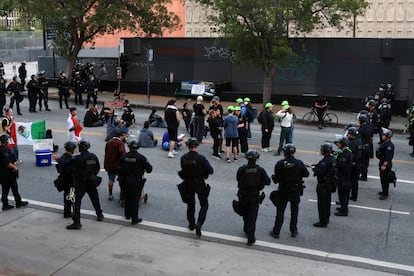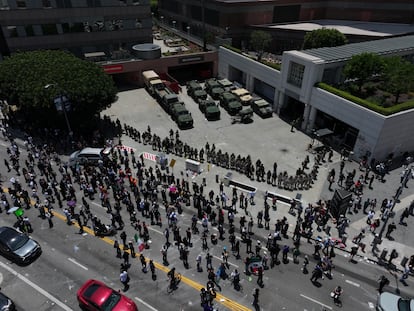Los Angeles immigration protests awaken dormant resistance to Trump
The deployment of Marines and National Guard troops to quell the protests goes to court this Thursday. Thousands of people marched for the sixth consecutive day in dozens of cities across the country

Los Angeles has been the spark that ignited anti-Trump anger almost five months after he took office. Last Friday’s immigration raids on the streets of the city with the second largest community of Mexicans after Mexico City sparked protests by hundreds of citizens and activists, leading the president to take one of those unprecedented decisions that defy all the rules of a country built on laws. The deployment of National Guard troops to quell the protesters without a prior request from Governor Gavin Newsom, has had a ripple effect throughout the rest of the country. Protests against immigration policy and the militarization of Los Angeles have now been taking place for six days in nearly 30 cities.
Wednesday was quieter than previous days. Images of clashes and mass arrests were not repeated, in part due to the curfew that has been in place in downtown Los Angeles since Tuesday night. But until just before 8 p.m., hundreds of people gathered for the sixth consecutive day in the streets of the country’s second-largest city. “Shame!” protesters shouted at the police, who tried to disperse demonstrators around City Hall with rubber bullets and tear gas. Protests also broke out in New York City—where there were five arrests—San Antonio (Texas), and St. Louis (Missouri).

The eyes of the protesters and the government itself are now focused on Saturday, a day on which the president has prepared a tailor-made birthday celebration. The event will include a military parade through the streets of Washington as its main event, but at the same time, hundreds of protests are scheduled across the rest of the country to demonstrate their rejection of the president. Trump has promised to respond with a firm hand: “I haven’t even heard about a protest, but you know, this is people that hate our country, but they will be met with very heavy force.”
Trump has already toyed with the idea of, as commander-in-chief, extending the militarization of Los Angeles to other cities, raising alarm bells about the type of security he plans to exert on the country. This is the first time in six decades that a president has ordered such a deployment, unseen since President Lyndon B. Johnson made the decision to allow Martin Luther King and other activists to demonstrate in Alabama.
The Trump administration has called the lawsuit filed by California to halt the militarization of Los Angeles “a political stunt.” Attorneys for the federal government responded Wednesday to the legal action initiated by Gavin Newsom, who called the deployment of 4,000 National Guard reserves and 700 Marines “unlawful.”
Emergency powers
Washington lawyers argue that Trump invoked discretionary emergency powers that do not require a local government request. “The statute empowers the president to determine what forces he considers necessary to suppress a rebellion or to execute federal laws,” the lawsuit states.

District Judge Charles Breyer, who was appointed by Bill Clinton, will decide Thursday afternoon whether to proceed with the case or dismiss it. Breyer declined to issue an emergency order on Tuesday at Gavin Newsom’s request. “These are men and women trained for foreign combat, not domestic law enforcement [...] We don’t want our streets militarized by our own armed forces,” the governor said, referring to the active-duty Marines who have been deployed.
The military personnel are scattered across eight locations in Los Angeles, where they are guarding a handful of federal buildings. Nearly 150 troops are monitoring the Homeland Security facility in the city of Paramount, near the spot where protests against Immigration and Customs Enforcement (ICE) raids took place Saturday. About 300, the largest group, are near Los Angeles International Airport. About 100 are accompanying ICE personnel as they execute arrest warrants against undocumented immigrants facing deportation orders. And about 32 are in Santa Ana, in Orange County.
General Scott Sherman, the commander of the troops who have arrived in Southern California, said that the troops are trained to temporarily detain anyone who attacks or impedes the work of ICE agents during raids. The arrest, however, must be made by a local or municipal security force. Relations between the various law enforcement agencies, which are not accustomed to working together, have become strained in recent days and are disconcerting to the protesters.
Sign up for our weekly newsletter to get more English-language news coverage from EL PAÍS USA Edition
Tu suscripción se está usando en otro dispositivo
¿Quieres añadir otro usuario a tu suscripción?
Si continúas leyendo en este dispositivo, no se podrá leer en el otro.
FlechaTu suscripción se está usando en otro dispositivo y solo puedes acceder a EL PAÍS desde un dispositivo a la vez.
Si quieres compartir tu cuenta, cambia tu suscripción a la modalidad Premium, así podrás añadir otro usuario. Cada uno accederá con su propia cuenta de email, lo que os permitirá personalizar vuestra experiencia en EL PAÍS.
¿Tienes una suscripción de empresa? Accede aquí para contratar más cuentas.
En el caso de no saber quién está usando tu cuenta, te recomendamos cambiar tu contraseña aquí.
Si decides continuar compartiendo tu cuenta, este mensaje se mostrará en tu dispositivo y en el de la otra persona que está usando tu cuenta de forma indefinida, afectando a tu experiencia de lectura. Puedes consultar aquí los términos y condiciones de la suscripción digital.
More information
Archived In
Últimas noticias
Most viewed
- Alain Aspect, Nobel laureate in physics: ‘Einstein was so smart that he would have had to recognize quantum entanglement’
- David King, chemist: ‘There are scientists studying how to cool the planet; nobody should stop these experiments from happening’
- Maps of the US attack on Venezuela: Targets, airspace and deployed fleet
- Key points of the military attack on Venezuela: Early morning bombings and a ‘captured’ president
- Trump says Washington will control Venezuela until there is ‘a safe transition’









































